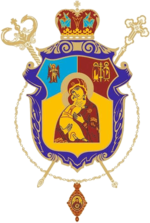Ukrainian Soviet Socialist Republic

The Ukrainian Soviet Socialist Republic (Ukrainian: Украї́нська Радя́нська Соціалісти́чна Респу́бліка, Ukrainska Radianska Sotsialistychna Respublika; Russian: Украи́нская Сове́тская Социалисти́ческая Респу́блика), abbreviated as the Ukrainian SSR, UkrSSR, or UkSSR, and also known as Soviet Ukraine, was one of the constituent republics of the Soviet Union from 1922 until 1991. In the anthem of the Ukrainian SSR, it was referred to simply as Ukraine. Under the Soviet one-party model, the Ukrainian SSR was governed by the Communist Party of the Soviet Union through its republican branch: the Communist Party of Ukraine. The first iterations of the Ukrainian SSR were established during the Russian Revolution, particularly after the Bolshevik Revolution. The outbreak of the Ukrainian–Soviet War in the former Russian Empire saw the Bolsheviks defeat the independent Ukrainian People's Republic, after which they founded the Ukrainian People's Republic of Soviets as a republic of the Russian Soviet Federative Socialist Republic in December 1917; it was later succeeded by the Ukrainian Soviet Republic in 1918, also under the Russian SFSR. Simultaneously with the Russian Civil War, the Ukrainian War of Independence was being fought among the different Ukrainian republics founded by Ukrainian nationalists, Ukrainian anarchists, and Ukrainian Bolsheviks—with either help or opposition from neighbouring states. As a Soviet quasi-state, the newly-established Ukrainian SSR became a founding member of the United Nations alongside the Byelorussian SSR, in spite of the fact that they were legally represented by the All-Union in foreign affairs. In 1922, it was one of four Soviet republics (with the Russian SFSR, the Byelorussian SSR, and the Transcaucasian SFSR) that signed the Treaty on the Creation of the Soviet Union. Upon the dissolution of the Soviet Union in 1991, the Ukrainian SSR emerged as the present-day independent state of Ukraine, although the Soviet constitution remained in use throughout the country until the adoption of the Ukrainian constitution in June 1996.Throughout its 72-year history, the republic's borders changed many times, with a significant portion of what is now western Ukraine having been annexed from eastern Poland in 1939, with significant portions of Romania in 1940, alongside another addition of territory in 1945 from Carpathian Ruthenia in Czechoslovakia. From the 1919 establishment of the Ukrainian SSR until 1934, the city of Kharkov served as its capital; however, the republic's seat of government was subsequently relocated in 1934 to the city of Kiev, the historic Ukrainian capital, and remained at Kiev for the remainder of its existence. Geographically, the Ukrainian SSR was situated in Eastern Europe, to the north of the Black Sea, and was bordered by the Soviet republics of Moldavia, Byelorussia, and Russia, and the countries of Romania, Hungary, Czechoslovakia, and Poland. The republic's border with Czechoslovakia formed the Soviet Union's westernmost border point. According to the 1989 Soviet census, the republic of Ukraine had a population of 51,706,746, which fell sharply after the Soviet Union's dissolution in 1991.
Excerpt from the Wikipedia article Ukrainian Soviet Socialist Republic (License: CC BY-SA 3.0, Authors, Images).Ukrainian Soviet Socialist Republic
Bulvarno-Kudriavska Street, Kyiv Центр
Geographical coordinates (GPS) Address Nearby Places Show on map
Geographical coordinates (GPS)
| Latitude | Longitude |
|---|---|
| N 50.45 ° | E 30.5 ° |
Address
Bulvarno-Kudriavska Street 29
01001 Kyiv, Центр
Ukraine
Open on Google Maps






